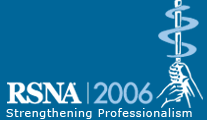
Abstract Archives of the RSNA, 2006
Marco Di Girolamo MD, Presenter: Nothing to Disclose
Daniela Prosperi, Abstract Co-Author: Nothing to Disclose
Tiziana Lanzolla, Abstract Co-Author: Nothing to Disclose
Vincenzo Ziparo, Abstract Co-Author: Nothing to Disclose
Vincenzo David, Abstract Co-Author: Nothing to Disclose
Francesco Scopinaro, Abstract Co-Author: Nothing to Disclose
The aim of this study was to assess the performance of 18F-FDG PET-CT for the detection of recurrence of colo-rectal adenocarcinoma, especially in patients who did not show any increase of tumor markers.
We have evaluated 45 patients preliminary submitted to radical surgery for colo-rectal cancer who had clinical or diagnostic imaging feature suspicious of a recurrence. All these patients underwent 18F-FDG PET-CT. 80% of these patients had low tumor markers. CT-PET images were obtained 1 hour after 18F-FDG injection and non contrast CT images were used for attenuation correction. The images obtained were fused for analysis. Patients were prepared with overnight fasting before 18F-FDG injection and the plasmatic glucose level had to be less than 140 mg/dl. The patient had to empty their bladder before PET-CT exam. In 3 patient two bed positions PET-CT scan were repeated after Foley’s catheter insertion and the injection of diuretic (Furosemide). Surgical revision after PET-CT diagnosis was considered as a gold standard.
We detected 9 patients with recurrence of colon-rectal cancer with 18F-FDG PET-CT. We found: 3 recurrence at the level of pre-sacral space after abdominal perineal resection using the Miles method, 1 costal metastases and 5 sub-diaphragmatic metastatic lymphadenopathy (4 retroperitoneal and 1 at the hepatic hilum). In a patient with a retroperitoneal metastatic lymph-node that infiltrated the ureter, the administration of furosemide allowed the elimination of artifacts due to the accumulation of 18F-FDG in the urinary system. The smallest lesion detected by 18F-FDG PET-CT was 8 mm in diameter. We had only a false positive case due to chronic inflammation after abdominal perineal resection (5 months after radiotherapy).
Our preliminary results showed that 18F-FDG PET-CT is the most accurate diagnostic procedure for the detection of recurrence of colo-rectal cancer and should be proposed in the early follow-up in patients with high risk of recurrence.
18F-FDG PET-CT should be proposed in the early and late follow-up in patients with high risk of recurrence of colo-rectal cancer.
Di Girolamo, M,
Prosperi, D,
Lanzolla, T,
Ziparo, V,
David, V,
Scopinaro, F,
Detection of Recurrence of Colorectal Adenocarcinoma with 18F-FDG PET-CT in Patients with Low Tumor Markers. Radiological Society of North America 2006 Scientific Assembly and Annual Meeting, November 26 - December 1, 2006 ,Chicago IL.
http://archive.rsna.org/2006/4438368.html

